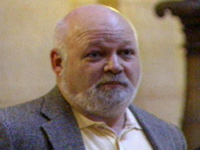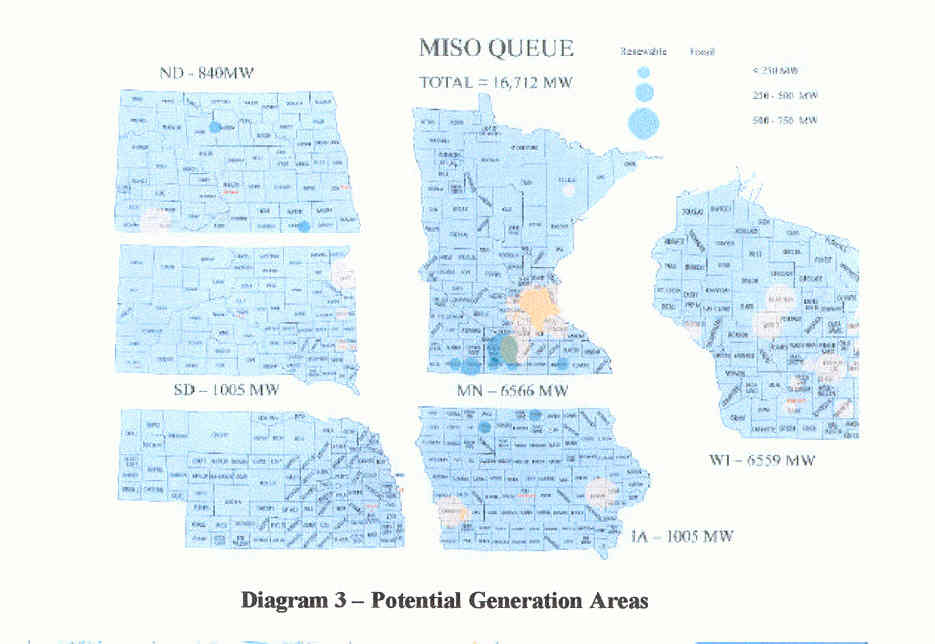Pawlenty supports wage hikes, insurance and better working conditions?
December 9th, 2005
This I gotta see… looks to me like this free marketer is painting himself into a ironic corner!
Naaaah, he’s probably headed more in this direction:
GOP Faction Wants to Change “Birthright Citizenship” Policy

I remember from my meat hauler days spending time, long long hours of waiting, in the meat packing plants of Minnesota and Iowa, and the way from the loading dock to the bathroom was always a long scenic route through the plant. Much of my take on immigration, legal and illegal, comes from that time, as well as from Julie Bursik who was the resident expert on Immigration Law at the International Center. For those who’ve never been inside a meat packing plant, well, imagine a cold hell, with animals hanging by their feet, workers struggling to keep up with the production line, hampered in movement and protected by chainmail aprons and gloves… and out in LA when I was delivering, I’d hear the IBP ads to get workers to move to Iowa, and what the ads didn’t disclose was that the unions had been busted, workers were being imported into socially isolated trailer parks, and sometimes local rage at union busting and replacement erupted into literal flames. I’ve also had several clients who were here illegally, and I learned a lot from their travails.
What would the impact be if the U.S. really did shut its doors to the laborers that certain industries depend on? Would Pawlenty really alter that tacit corporate deal? What is Pawlenty thinking of in terms of policy that won’t have a detrimental affect on his corporate masters? Where is he going? Could it be that Pawlenty would turn meatpacking, nursery/landscaping, construction, hotel and restaurant industries on their heads — that he’d increase wages, require insurance and improve working conditions such that U.S. workers could support a family at the jobs typically filled by illegal immigrants?
Or does he propose to ease immigration requirements so they’re not “illegal?”
State ties steep costs to illegal immigration
From that article:
Pawlenty first hinted a policy move on illegal immigration after President Bush addressed the issue last week. Two days later, Pawlenty visited Worthington in southwest Minnesota, a city of 11,000 with a large immigrant population, to discuss the issue with community leaders. This week he held a similar session in Rochester, another city with many immigrants.
“We have heard a broad variety of concerns about education, health care, housing and law enforcement,” McClung said. “You cannot justify the current chaotic immigration system by saying it provides cheap labor. It creates an underground economy and opens people up to exploitation.”
Thursday’s report was produced by the Department of Administration, whose commissioner, Dana Badgerow, called its findings “alarming.”
It estimated the number of illegal, or undocumented, immigrants in Minnesota at 80,000 to 85,000, more than the numbers in at least 20 other states. An estimated 17,000 of their children cost public schools $146 million to $158 million to educate in 2004, and another $30 million went to costs for subsidized health care and incarceration for crime, the report said. “In addition, illegal immigrants arguably displace American workers, which contributes to lost jobs and wages,” it said.
…
Immigrant contributions
Legislation adopted in 2003 barred illegal immigrants from most health and welfare assistance, except emergency and pregnancy services, to which the report attributed an annual cost of $17.3 million. And the Department of Corrections estimated a cost of $12.8 million for imprisoning 501 illegal aliens in the year ended June 30.
An unknown portion of those costs is offset by taxes paid by illegal immigrants, the report said. About 8,000 file state income tax returns; many others don’t, but taxes deducted from their paychecks remain in state coffers.
Focusing on illegal immigrants’ costs without counting their contributions doesn’t make sense, said Jared Erdmann, co-director of Hacer, a Hispanic research organization in the University of Minnesota’s Humphrey Institute of Public Affairs. He said a Hacer study estimated the buying power of Latinos, believed to make up the bulk of illegals in Minnesota, at $3.1 billion. Migrants, both legal and illegal, have revitalized entire neighborhoods, he added.
Here’s the link to the actual report:
The Impact of Illegal Immigration on Minnesota
And here’s another article from the STrib:
Minnesota’s illegal workers in the spotlight
Oh, ya think Pawlenty might not support wage hikes, insurance and better working conditions? Well, there was that Executive Order telling unions where to go… so what might he do that’s not a draconian and punative political liability?
Corruption in the extreme
December 8th, 2005
Lately, I’ve been thinking of deals and lies and extortion and greed and deals and lies and scams and blackmail and deals and lies in the public arena, supposedly for the public good. Yeah, right… And I was also thinking of the former Mayor of St. Croix Falls, and Loren Jennings, formerly Representative and now felon, as I blew past Harris, the Chisago area, on the way up North this week, wondering in the very, very large sense what all we don’t know about what goes on in the name of “public interest,” what goofy schemes are called “public policy” and where that leaves us… My guess is that most of us would be suprised at what all is for sale and how low the price.

Stolen from www.kstp.com
Here’s news in the St.PPP of another corrupt official, former Wisconsin state Senator Chuck Chvala, another one with utility ties:

Stolen from Milwaukee Journal Sentinal Online
Here’s some context from Milwaukee’s Journal Sentinal:

One of my favorite books is Sissela Bok‘s “Lying,” and of course “Secrets.” Lying has a powerful section on instutional lying, the kind of things people tell themselves when they’re involved in utterly immoral activity, palliatives for politicians’ guilty conscience. And the impacts are broad:
… citizens the world over have less confidence that they can influence what governments do.
The loss in confidence benefits individuals to an externt. Those in a position to resist oppression by bureaucracies will do so, and fewer can be talked into fighting senseless wars. But the major effects are surely negative. For insofar as problems have to be met jointly — problems, for example of disarmament, energy, or population — the fact that government information cannot be trusted is crippling. Bona fide efforts in the joint interest are thus undercut by the cynicism and sense of powerlessness which result from the knowledge of large-scale decpetion.

If we assume the perspective of the deceived — those who experience the consequences of government deception — such arguments are not pursuasive. We cannot take for granted either the altruism or the good judgment of those who lie to us, no matter how much they intend to benefit us. We have learned that much deceit for private gain masquerades as being in the public interest. We know how deception, even for the most unselfish motive, corrupts and spreads. And we have lived through the consequences of lies told for what were believed to be noble purposes.
Lying, p. 144,169 (emphasis added)

Binary Alternate Realities – the Pawlenty version
December 6th, 2005
Tonight was another of the Bull Renewable Energy shows, this time up on Eveleth, which works out well because I’ve got to be in Grand Marais tomorrow. BUT, much as I enjoy my role of advocating for a different reality, I’m having trouble seeing the point of the Pawlenty administration’s belief that we’re doing just great in renewable energy — how can that be when you consider the big picture? We have plenty of generation and we can CHOOSE our sources of generation – “need” of 6,300MW in region by 2020, 16,712 in MISO queue as of the CapX2020 report, p. 7, and here’s that great little map that shows it all:

If I accomplish anything in this lifetime, I want to have this map imbedded in everyone’s eyelids long enough to understand — it’s not that difficult, but there’s way too much resistence. It’s simple, once more with feeling:
16,712 – 6,300 = 10,412 MW of wiggle room.
How can anything renewable be “progress” and what difference does it make when right now we’re “choosing” other noxious options? Right now, in this binary moment where we’re putting in billions of dollars of infrastructure, we’re faced with about 12-14 new transmission lines, new construction of many old-style coal plants, corporate welfare Mesaba at our expense, and the big money on central station wind and hundreds of miles of transmission with 30-40% line loss, yeah, so what if “we’re #1,” it has nominal impact at best. WE’RE MAKING THE WRONG “CHOICES.”
If we’re building billions of infrastructure that lasts 50-80 years, so what! There’s not much room for renewables when we’re already overloaded with electricity, evidenced in the push for an RES that creates a market! How much well-sited wind does it take to overcome hundreds of MW sited a long way from load? It takes at least three turbines in SW Minnesota to equal two turbines sited near load. How much “clean coal” to offset the “dirty” coal and who is going to make sure the water isn’t contaminated as it is near every other coal gasification project? And again, don’t forget that with the line loss, they must produce an extra 30-40% to make up for that, roll in an extra 30-40% more coal trains, use an extra 30-40% more water. What good is any of this “clean coal” and renewable development when they’re building the old style unsustainable plants and infrastructure and we’re paying for it? Why pretend that carbon sequestration is any solution? It’s nuts, ain’t gonna happen, and it’s not the way to deal with CO2 emissions because it’s very costly, can’t be done here, and it leaks and escapes — it’s false hope and wasted grant money. Why pretend that old style coal plants won’t be built, that renewables will replace noxious generation — it’s false. Color me tired — tired of project announcements that keep coming by every possible means of projects that should constitute “our worst nightmare.” Where’s the outrage?
Sen. Tomassoni did claim Mesaba as “his” and wants me to join in support of it, after all, it’s better than the old ones, but this presumes that if Mesaba is built the others won’t be and that’s just not the way it works. They ARE building the new coal plants. Someday I do hope we can talk about the water problem, little things like selenium, cyanide and arsenic, and I’ll keep forwarding info as I get it, but right now, my focus is on the bigger picture, the hallucination of improvement, that we’re in the lead, when from what I can see, which in energy is a lot, we’re right down the crapper. “We’re” making policy choices that put us solidly down the “been there-done that” path of more central-station coal, and that’s not where I want to be. The commitments, though not made yet, don’t have much of a chance of derailment, though I, the eternal optimist, will keep looking for a way. In simple logistical and financial terms, who can afford to challenge these plants and transmission lines? Those with the resources aren’t about to put up a meangingful challenge and those with these noxious facilities in their communities cannot afford the fight. So where’s the good news? Where’s the outrage?
Enough — off to Grand Marais!
Utility Personal Property Taxes – Itasca County
December 4th, 2005

Economic Development (with capital letters) is more than just “jobs, jobs, jobs.” That’s what infuriates me about this JOBZ zone crap, because it usually just shifts companies around to whatever locality is chump enough to give them free ride on property taxes and income taxes, meanwhile driving up infrastructure costs that are not supported by the entity that causes it, GRRRRRRRRRRRRRRRRRRRR, if I ruled the world, the corporations would pay their own freight. JOBZ, TIF, tax “abatement,” everywhere we turn, it’s corporate welfare at our expense.

Then you’ve got this Mesaba coal gasification project, getting every “incentive” from the government trough that you can think of, and some that only Tom Micheletti could have thought of — I’ve got to hand it to him, he’s VERY creative, but there’s no excuse. They’ve gotten money from the state’s Renewable Development Fund ($10 million over 5 years), the IRRRB or IRRA or whatever it’s called now has paid in millions too, and the DOE with $36 million plus the $800+ million in federally guaranteed loans, we’re paying for that. To top that off, they went to the Counties, Itasca and St. Louis, so they’re covered wherever it goes, and got another $50 million for infrastructure from each. Say WHAT? How can these counties afford that?
They can’t. They’ve figured that out. This money has to come from somewhere.
An article in the Grand Rapids Herald-Review shows that Itasca County is listening. They’re under fire from citizens who’ve just received their tax bills, constituents who are staggering under the increase and are outraged. The county has taken an objective look at the income and outgo and they know who is paying their fair share — they know that utilties tax rates have been cut. Is that fair? Here’s a part of the article:
Frustration vented at county Truth-in-Taxation
That situation has become a reality in Itasca County, said McLynn, when utility companies, such as Minnesota Power, which operates Clay Boswell in Cohasset were given property tax relief a few years ago. Those missing revenues are now being covered by homeowners.
Information distributed by the county auditor indicated that over the past three years, utility taxes have dropped significantly.
Public utilities accounted for 21 percent of the county property tax base in 2002 while in 2005, that percentage is projected to be 13.7 percent. During the same period of time, homestead property taxes have risen from 30 percent of the property tax base in 2002 to a projected 35 percent in 2005.
A county that’s already hurting financially cannot afford that kind of hit. In Goodhue County, our utility personal property tax revenues from the Prairie Island plant were cut by more than half, from $23 million to $10 million. Download file THAT HURTS!
Itasca County knows that the bill will fall due, that all these perks of corporate welfare aren’t free, they are paid for by the county taxpayers. Can they afford to support projects like this? Can they afford to support projects like this without getting their fair share from the power plant? Let’s ask them!
Sviggum’s stumping for Ray Cox again
December 3rd, 2005

Sampling of local lawmakers shows less eagerness to take credit for rebounding state budget
On the other hand…
Today Speaker Sviggum isn’t issuing threats to file complaints about pie or popsicle bribery, and he’s not holding a press conference standing in the fall sun in the smelly Rice County dump with ex-Rep. Lynda Boudreau and Ray Cox, or in the Austin dump for that matter (note both of those stunts were both done in the same districts?). But he’s stumping for his good buddy Ray Cox on the editorial page, this time saying that we can thank Rep. Ray Cox for Minnesota’s budget surplus. Uh-huh…we can thank Ray Cox for eliminating the deficit and creating a surplus… right… well, the good news is that apparently Steve thinks Ray needs help, and it looks like he has learned something about appropriate behavior for the Speaker of the House!
To the editor:
The state of Minnesota recently completed the greatest economic turnaround in its history by eliminating a $4.5 billion deficit and creating a $701 million surplus. For this, you can thank state Rep. Ray Cox.
Rep. Cox, R-Northfield, realized that sound fiscal management would eliminate the state budget shortfall crisis. Though he knew raising state taxes would be the easiest way to solve this problem, he instead took difficult votes to reduce state spending. His actions helped lead us out of the deficit and put Minnesota’s finances back in the black.
Time and time again, Ray Cox has shown his leadership by making tough decisions in the face of adversity. He knew that better management of your tax dollars and an improvement in Minnesota’s job climate would turn our economy around. The recent $701 million surplus proves he was right.
Steve Sviggum
Speaker of the House
Minnesota House
of Representatives
Kenyon